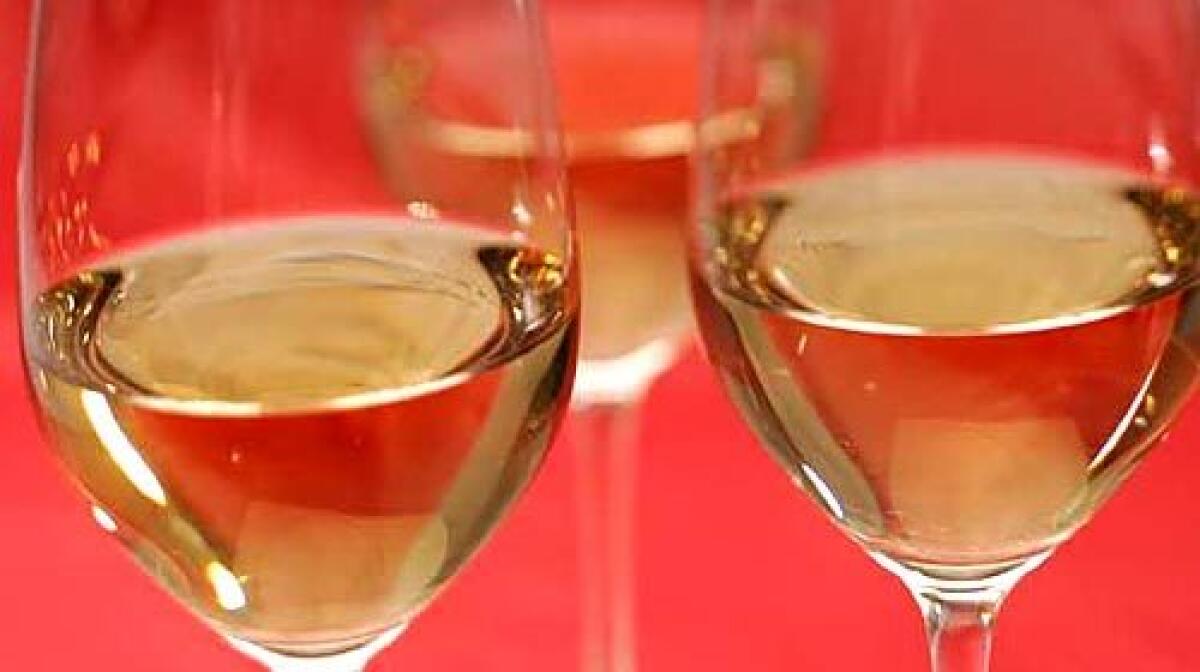Chilled seafood’s perfect partner: Chablis

GLOBAL warming may turn out to be the undoing of the human race, but as long as there are still plateaux de fruits de mer to be devoured in the corner brasserie, there’s an upside: how the weather’s changing Chablis.
Village Chablis, lustrous, minerally and racy yet delicate, has always been textbook-perfect with oysters on the half-shell, but a little too steely for the sweet meat of lobsters and crab. But as the world heats up and vintages yield riper grapes and richer wines, more and more of the cru sites of Chablis, one of France’s most northerly appellations, are producing wines with just enough ripeness and richness to work with everything on the plateau -- lobsters and Dungeness crab and mussels and sea snails and, yes, oysters.
Chablis is less than 100 miles from the outskirts of Paris, and it has traditionally been thought of as pushing the outer limit of where wine grapes can fully ripen. In some vintages, they simply don’t: The region is routinely threatened with every potential cool-climate disaster -- frost, rain, hail and freezes . In recent years, however, climate changes have drawn this very marginal place away from the margins. Growers are now blessed with warmer, shorter growing seasons, and weather threats are rarer.
In some vintages, the character of the wines has changed too. Warmer weather means riper fruit, more ample textures and generally richer wines. “The most obvious change,” says Véronique Drouhin, “is that the harvest comes earlier.” Drouhin and her brother Philippe are both scions to the great Burgundy négociant house Domaine Joseph Drouhin -- Véronique as winemaker, Philippe as vineyard manager -- and have been watching the weather for more than 20 years. They say that the effects of changes in climate patterns, while rampant in all of Burgundy, are most extreme in Chablis: Harvest in their father’s time used to occur in October; now mid-September is the norm, and August is not unheard of.
Nevertheless Philippe, who tends vines from Chablis to Beaujolais, continues to place his trust in that classic French terroir element, the soil. “The expression of a wine remains linked with the nature of the soils,” he says, “Just because it’s warmer, the character doesn’t go away.”
That taste of minerals
CHABLIS sits at the edge of a great geological formation known as the Kimmeridgian Chain, a layer of limestone marl, some of which is composed the skeletons of trillions of sea creatures -- a formation that stretches from England to Champagne, Burgundy, and the eastern Loire Valley in France.
As a result, Chardonnay from Chablis is fantastically mineral; that soil element, with its aromas of flint and wet stones, combined with classic, cool climate acidity, results in a mouth-feel that’s almost impossibly attenuated, delicate and refined.
The great character-defining sites in Chablis have been designated grand cru or premier cru, and are typically situated on hillsides composed primarily of this limestone marl. But they’ve also been the warmest sites, the ones with the best exposure and best orientation to the sun -- the best chance for ripeness in a challenging environment. In an appellation where “richness” is a relative term, wine from the cru sites have always been the most ample. Wines from sites with poorer exposure tended to be less ripe and remain tense and steely.
But longer heat waves, notes Véronique, have evened the playing field somewhat. “It’s more extreme,” she says, “either very warm for a long time or very cool for a long time.” Although she thinks this may lead to more even ripening, it may, she says, come at a price for complexity, particularly in the retention of acid. For some wines, this means that the balance is starting to teeter.
Traditionally Chablis has been such a marginal region that acidity has never been a concern. Then came 2003, a year so freakishly warm that some winemakers actually had to add tartaric acid to their tanks to give the wines proper balance.(More typically it’s the other way around; they’ll chaptalize, or add sugar to counterbalance the wine’s tartness.) For three of the last four years (2004 being the exception), Chablis wines have been able to achieve the proper levels of ripeness without additional sugar. In grand cru and premier cru sites especially, the wines have never been more natural.
Tasting these wines, you get an object lesson in how acids and minerals interact. In cool weather vintages such as 2004, the wines fairly pulsate with energy; there’s a nervous quality to the texture, a whippet’s jittery grace. The acidity and minerality are working in such harmony that it’s very hard to separate the two. Comparing the 2004 vintage of premier cru “Vaillons” from Jean Collet with the 2005, for example, leaves little doubt as to which is the cooler vintage; the 2005 is a riper wine redolent of quince and golden apples, while the 2004 is still lime-scented and tight as a drum, even though it’s a year older.
This isn’t an entirely fair comparison -- a young wine is usually the more forward and fruity -- but in general, in the wines from warmer vintages, that lock step between mineral and acid has fallen slightly out of sync. The middle palate in the 2005 wines I tasted seemed fleshier, mildly distended, and especially from the more chalk-laden grand cru and premier cru sites, the minerality actually seemed more pronounced -- I’m guessing that the absence of acidity allowed the mineral component to forge a more central role.
In wines that were inherently less mineral (in regular, “entry level” Chablis bottlings) the missing acidity was more obvious. Although cru sites may have lost a bit of acidity, they still bear the advantage of a highly mineral site, which gives the wines added traction. Wines from lesser sites lack the mineral bite that the cru sites provide, and the crisp boost that acidity contributes is wanting.
But interestingly, suddenly there’s fruit to speak of. In Chablis wines in “normal” vintages such as 2004 that’s a component that may scarcely have been mentioned in your average tasting note. The few 2006s I was able to taste were wonderfully exuberant and lively in their youth. Their fruit is attentive and forward; it more than accommodates the wine’s newfound amplitude.
Ripening under a strict eye
IT used to be that a Chablis grower’s only concern was achieving full ripeness. Now, to maintain classic Chablis’ elegance, it’s necessary to guard against overripeness. That means slowing down the growth cycle in the vineyard. “I have to pay attention now to not exposing the grapes too much in the sun,” says Michel Laroche, who just completed his 40th vintage in Chablis. “I used to pull leaves on the shadow side of the trellis. I still do that, but I pull less leaves than I used to and sometimes not anymore.”
Riper fruit inevitably leads to higher alcohols, to which all Chablis winemakers are deeply sensitive. Traditional wines in Chablis come in at about 12% to 12.5% alcohol (a typical California Chardonnay these days is rarely under 14%). Now 13 is appearing more regularly on labels, and some winemakers, including Jean-Marie Guffens at Verget, have taken to rejecting large amounts of fruit at harvest for fear it will yield alcohol levels they’re uncomfortable with. Others, such as Olivier Savary, will produce stubbornly racy wines such as the 2005 Vieilles Vignes bottling, which was easily the steeliest, leanest wine among those I tasted from the vintage, but was the exception, not the rule.
“We’re certainly producing a style of wine that’s a little richer, more opulent,” Laroche admits, but he’s quick to add that he doesn’t see this as a problem. Chablis’ greatest 20th century vintages, after all, were its warmest. “When you look back at the history of the vintages, always the good years had the warm summers. The famous vintages -- 1947, 1966, 1989 -- all these summers were very hot.”
“Even if it’s true that we’re ripening earlier,” says Philippe Drouhin, “closer to the rest of Burgundy, the wines here will still be higher in acidity and lower in sugar content than the Côte d’Or. You don’t lose typicity unless you let the fruit get too ripe. Overripe Chardonnay is still uncommon in Chablis. That’s more a decision of the winemaker.”
For the moment, says Laroche, warmer vintages can be managed in the winery in a variety of ways. For example, he can modulate the wine’s perceived acidity by changing his fermentations in the cellar -- in particular, he’s cut back on his malolactic fermentations, retaining more crisp, appley malic acids and restricting the broader lactic acids that tend to round out a wine’s texture. And he has adopted screw-caps for all of his wines, to help with their longevity.
The world’s climate keeps changing, and Chablis will change with it. The lean wines we’ve craved with oysters are bound to move into richer territory as well.
“The conclusion is, we’re thrilled,” says Véronique Drouhin. “We just need to be careful not to go too far.”
More to Read
Sign up for our L.A. Times Plants newsletter
At the start of each month, get a roundup of upcoming plant-related activities and events in Southern California, along with links to tips and articles you may have missed.
You may occasionally receive promotional content from the Los Angeles Times.






